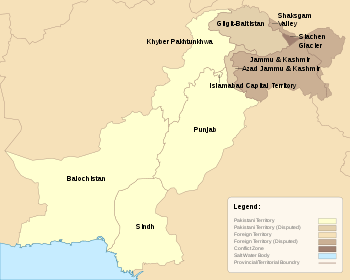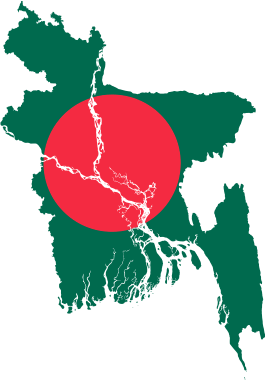One Unit
The One Unit (Urdu: ایک وحدت) was a geopolitical programme launched by the Government of Pakistan led by the then-Prime Minister Muhammad Ali Bogra on 22 November 1954. The government claimed that the programme would overcome the difficulty of administering the two unequal polities of West and East Pakistan separated from each other by more than a thousand miles.[1] To diminish the differences between the two regions, claimed the government, the 'One Unit' programme merged the four provinces of West Pakistan into a single province to parallel the East Pakistan (now Bangladesh).

Part of a series on the |
|---|
| History of Bangladesh |
 |
|
|
Ancient
|
|
Classical
|
|
Medieval
|
|
Modern
|
|
|
Related articles |
|
|
Part of a series on the |
|---|
| History of Pakistan |
 |
| Timeline |
|
Ancient
|
|
Classical
|
|
Medieval
|
|
Early modern
|
|
Modern
|
|
History of provinces |
|
Pakistani scholars and researchers maintain that the One Unit programme was viewed as a counterbalance against the political and population domination of the ethnic Bengali population of East Pakistan.[2][3] The One Unit program was met with great resistance and grievances were raised by the four provinces since its establishment. The National Awami Party successfully sponsored a bill in the National Assembly calling for its dissolution and providing for regional autonomy. This led to the military takeover of the national government.[4] The One Unit programme remained in effect until 1970.[1] Finally, President General Yahya Khan imposed Legal Framework Order No. 1970 to end the One Unit program and reinstate the provisional status of the Four Provinces as of August 1947.[1]
History of 'One Unit Scheme'
Although (according to the official Pakistan history),[5] Pakistan was conceived by philosopher Sir Muhammad Iqbal in 1930 (uniting the four states of the northwestern British Indian Empire), the country was established on 14 August 1947, directly resulting from the Pakistan Movement led by Muhammad Ali Jinnah. Since then, the country had been without a consolidated written constitution, and all Pakistan's state affairs had been run under constitutional acts of the British Indian Empire, such as the Government of India Act 1935 and the Indian Independence Act 1947.
The Government had prolonged difficulty in administrating East Bengal, with its border with Eastern India, and the four provinces, which border Western India, Iran, China, and Afghanistan.
One Unit was conceived by then-Governor-General Malik Ghulam and drafting was completed by then-chief Minister Mumtaz Ali Doltana. The first official announcement about it was made on 22 November 1954. Rationalizing the framework, Bogra enumerated the benefits of having one unit or province: "There will be no Bengalis, no Punjabis, no Sindhis, no Pathans, no Balochis, no Bahawalpuris, no Khairpuris. The disappearance of these groups will strengthen the integrity of Pakistan." [6] The Prime Minister Chaudhry Muhammad Ali implemented the framework of the One Unit program on 14 October 1955 after Pakistan National Assembly passed a bill merging all of West Pakistan into a single province on 30 September 1955.
1. It would end the curse of provincial prejudices.
2. It would allow the development of backward areas.
3. It would reduce administrative expenses.
4. It would make it easier to draw up a new constitution.
5. It would give East and West Pakistan maximum autonomy.
(The reasons given to the Assembly for adopting the One Unit Scheme by Iskander Mirza in September 1955.)[7]
After the 1954 general election, the four provinces and Tribal Areas were merged in the western wing. The province was composed of twelve divisions and the provincial capital was established at Lahore. The province of East Bengal (including Sylhet and the Hill Tracts) was renamed East Pakistan with the provincial capital at Dacca. The federal government moved the country's capital in 1958 from Karachi to Rawalpindi (serving as provisional capital until Islamabad was ready), while the federal legislature moved to Dacca.
West Pakistan formed a single and united political entity but with marked linguistic and ethnic distinctions. The One Unit policy was regarded as an administrative reform that would reduce expenditure and help eliminate ethnic and parochial prejudices. However, with the military coup of 1958, trouble loomed for the province when the office of Chief Minister was abolished and the President claimed executive power over West Pakistan. The province of West Pakistan was dissolved on 1 July 1970 by President General Yahya Khan.
References
- "One Unit". Story of Pakistan. Retrieved 16 May 2013.
- Ahmed, Feroz (1998). Ethnicity And Politics In Pakistan. Karachi: Oxford University Press. pp. 26–27. ISBN 0195779061. Retrieved 19 February 2020.
- Khan. Politics of Identity: Ethnic Nationalism and the State in Pakistan. Sage Publications. p. 66. ISBN 8178294273.
- Talbot 1989, p. 86.
- Sevea, Iqbal Singh (2014). The Political Philosophy of Muhammad Iqbal: Islam and Nationalism in Late Colonial India. Cambridge: Cambridge University Press. pp. 25–26. ISBN 1139423789. Retrieved 19 February 2020.
- The History And Culture of Pakistan, by Nigel Kelly. Retrieved 16 August 2015
- The History And Culture of Pakistan, Nigel Kelly. Retrieved 16 August 2015
Bibliography
- Talbot, Ian (1998), Pakistan: A Modern History, St. Martin's Press, ISBN 978-0-312-21606-1
External links
- Formation of One Unit , storyofpakistan.com website, West Pakistan Established as 'One Unit' province on 30 Sept.1955. Retrieved 16 August 2015